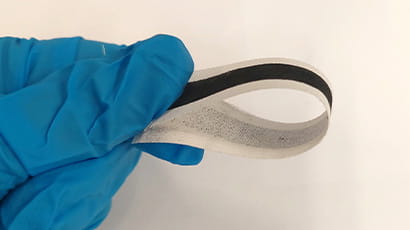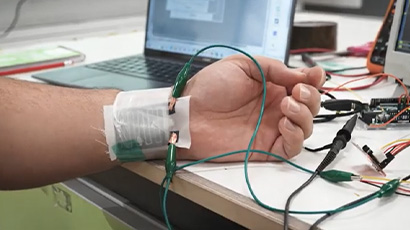UNESCO world heritage sites brought to life for the visually impaired

UNESCO world heritage sites from across Europe have been recreated into 3D tactile models with built in audio technology that allow people with visual impairments to learn, feel and engage with history.
Four heritage sites including Basicica Aquileia (Italy), Alhambra Palace (Spain), Sibenik Cathedral (Croatia) and Rila Monastery (Bulgaria) were replicated, with manufacturing and production of the models carried out by researchers at the Centre for Fine Print Research at UWE Bristol.
Funded by the EU commission, Unesco4All Tour is a project made up of a consortium of partners from across Europe with the aim of creating an accessible tourism product for visually impaired people, thereby making art and history more inclusive.
The models replicate the texture, design and structure of the historical sites and their artefacts which users can engage with through touch and feel. The models also contain a number of built-in electronic near field connectivity (NFC) sensors which are triggered by a small ring-like device worn by users as they run their hands over various parts of the model. Once triggered, the ring device vibrates and activates an audio guide connected to an app on the users’ smartphone or tablet, creating a multi-sensory experience.
Researcher and Associate Professor of the CFPR, Fabio D'Agnano said: ‘‘It is vital that we continue to make our cultural spaces as accessible and inclusive as possible, giving people with disabilities the opportunity to engage with history and art. Unfortunately, many museums, galleries and heritage sites still have significant barriers for visually impaired people, especially as many of these spaces do not allow you to touch the exhibits. This project shows how these barriers can be overcome with the utilisation of new technology and how much those with visual impairments can benefit.’’
Each model took hundreds of hours to create with several stages of production carried out by researchers at the CFPR. This included translating real objects into digital models through photogrammetry, digital 3D modelling and digital sculpting. Digital models were then built using a variety of materials and techniques including Computer Numerically Controlled (CNC) routing, laser cutting and engraving, and resin 3D printing. One of the main challenges for researchers was to create a precise replica of an artefact, of considerable size and at reasonable expense, while ensuring the material was easy to maintain and pleasant to touch.
Mr D’Agnano added: ‘‘A huge amount of time and consideration went into developing these models so that we could create the very best multisensory experience. The views of visually impaired people were crucial throughout the process and focus groups were held to gather their feedback on the usability and design of the models. I am extremely proud of what the project has achieved and hope many more historical sites and museums consider using this technology.’’
Earlier this year, Unesco4All Tour was selected as the best project in the Shaping Europe’s Digital Category at the EU Industry Days 2021 conference; one of the flagship events of the European Commission.
Related news

03 January 2025
Big leap forward for environmentally friendly ‘e-textiles’ technology
Research led by UWE Bristol and the University of Southampton has shown wearable electronic textiles (e-textiles) can be both sustainable and biodegradable.

22 May 2024
Academic retraces footsteps of Victorian photography pioneer behind Led Zeppelin album cover
A UWE Bristol researcher has used old-fashioned photography methods to recreate images by a Victorian photographer noted for taking an iconic photo that became a Led Zeppelin album cover.

15 May 2023
Glow in the dark gemstones show the jewellery industry that laboratory-grown crystals can shine bright
A UWE Bristol researcher hopes to revolutionise the jewellery industry and its supply chains with the creation of unique gemstone and jewellery designs with ground-breaking properties - including the world’s first single stone glow-in-the-dark manmade crystal.

21 February 2023
UWE Bristol pioneers the development of wearable health-monitoring e-textiles
The reality of everyday use of sustainable wearable electronic textiles for personalised health monitoring has moved one step closer.

21 July 2021
Prototype scanner reveals inner workings of renowned 18th-century painter
Canaletto's artistic methods have been examined by researchers at the Centre for Fine Print Research at UWE Bristol using a prototype scanner.

28 September 2020
Major interventions needed to meet global demand for PPE, say scientists
More investment in PPE technology and research and regional manufacturing centres are recommendations in a comprehensive review of the provision of PPE.

05 August 2020
UWE Bristol project to create lifelike organ simulators using 3D printing
Researchers are exploring how 3D technology can be used to improve surgical training by creating organ simulators which look and feel like real body parts.

14 June 2019
£7.7m investment for UWE Bristol's print research centre
UWE Bristol's Centre for Fine Print Research (CFPR) is to receive a £7.7m grant from Research England's Expanding Excellence fund.






